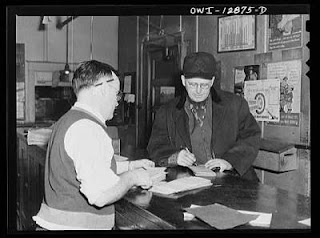Make it beautiful. SwitchList's paperwork shouldn't look like it was printed on a twenty-year-old IBM PC (unless the real switchlists were). Forms should be handwritten. Bonus points for adding greasy fingerprints automatically.
Now, beautiful and realistic is a nice goal. But real railroaders didn't always start off with switchlists. The decisions about which cars a train would move started when the conductor picked up his stack of waybills, the official record of what the car was carrying and who was being billed for the cost of transportation. The switchmen might use the waybills to make their own switchlist cheat sheets, but the waybills were the primary source of truth.
Tony Thompson has written several blog articles over the last year about how the car cards he uses are meant to resemble the look of a typical waybill, or some of the other typical railroad paperwork. They look great... but I don't use car cards, I use switchlists. So could SwitchList generate waybills like it generates switchlists?
With SwitchList's custom switchlist templates and a bit of web savvy, it's certainly possible. The photo shows the result of a few day's work - an example waybill with values filled in straight from SwitchList. Making this required the same kind of work as making a web page - describing the waybill's graphic design using HTML, using SwitchList's template language to indicate where car initials and numbers get filled in, and a little magic code to make a guess at the car's potential route.
I've made the custom template to generate Waybills public; it's experimental and a bit rough, but if you're interested in making a complex switchlist template, it might give you some hints. You can copy the template from code.google.com). It isn't yet included with the SwitchList program; instead, copy the files down and install them as mentioned in the README file.
Better yet, if you have an iPhone, then you can see the switchlists in detail when you connect to SwitchList through its web interface. Best of all, you can swipe with your finger to look at the previous and next waybill.
Try out a demonstration of the SwitchList Waybill template on your iPhone (or computer) by clicking on this example. (If you load it into your computer's web browser, change which waybill you're looking at by pressing the mouse button and dragging the mouse.) I'm still a big fan of giving my operators a paper switchlist, so I'm probably unlikely to encourage people to browse waybills on their phone, but you might find this just what your layout needs!
Comments and suggestions welcome.
[Photo: Jack Delano photo for the Farm Security Administration, 1943. From Library of Congress.]





No comments:
Post a Comment
Note: Only a member of this blog may post a comment.